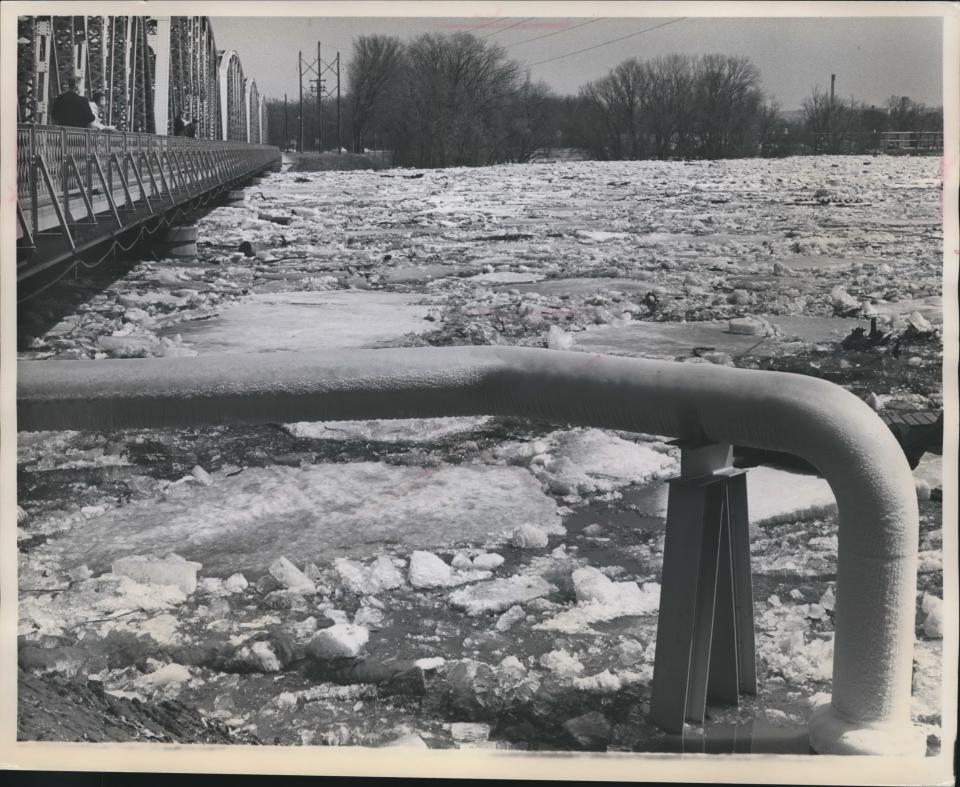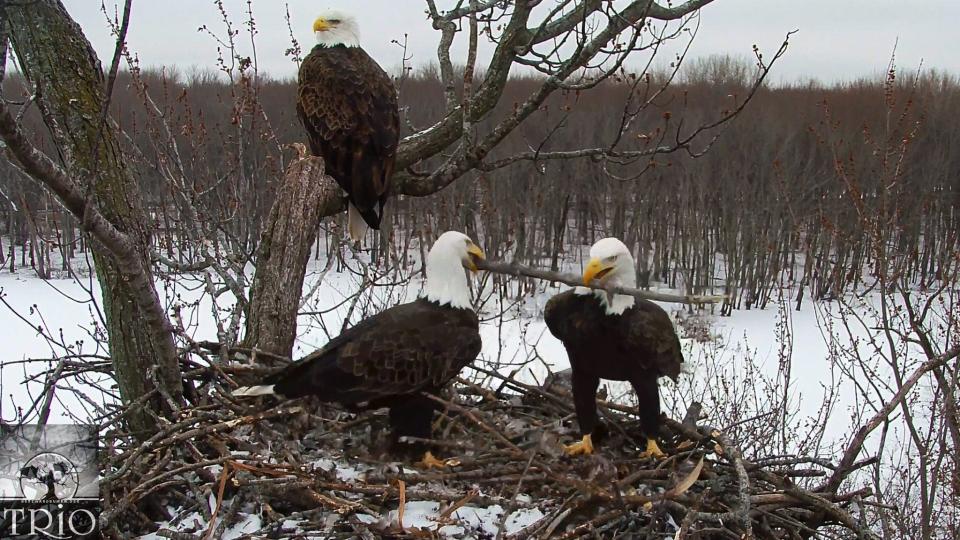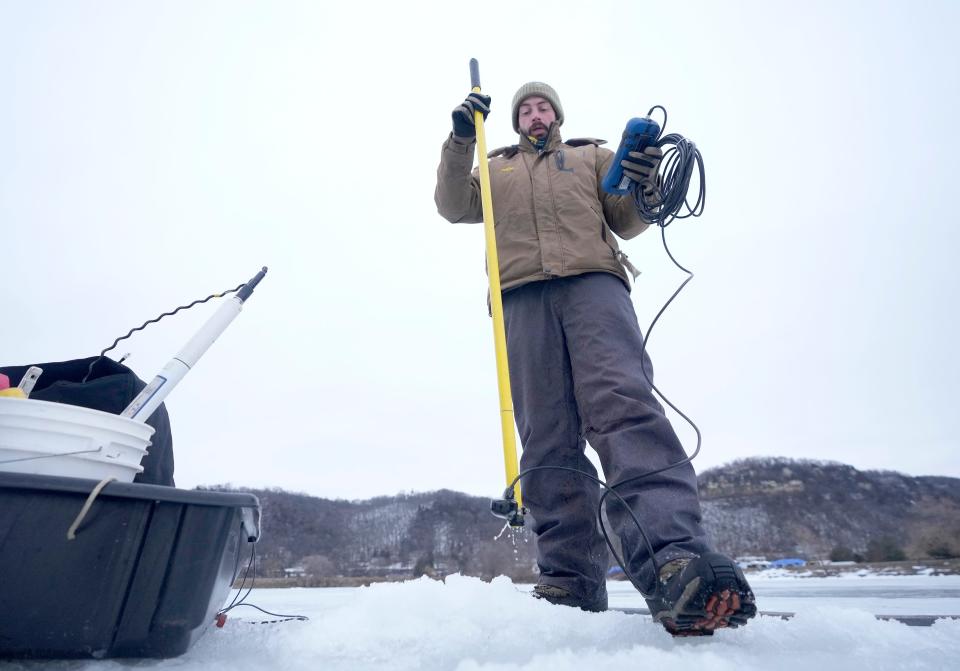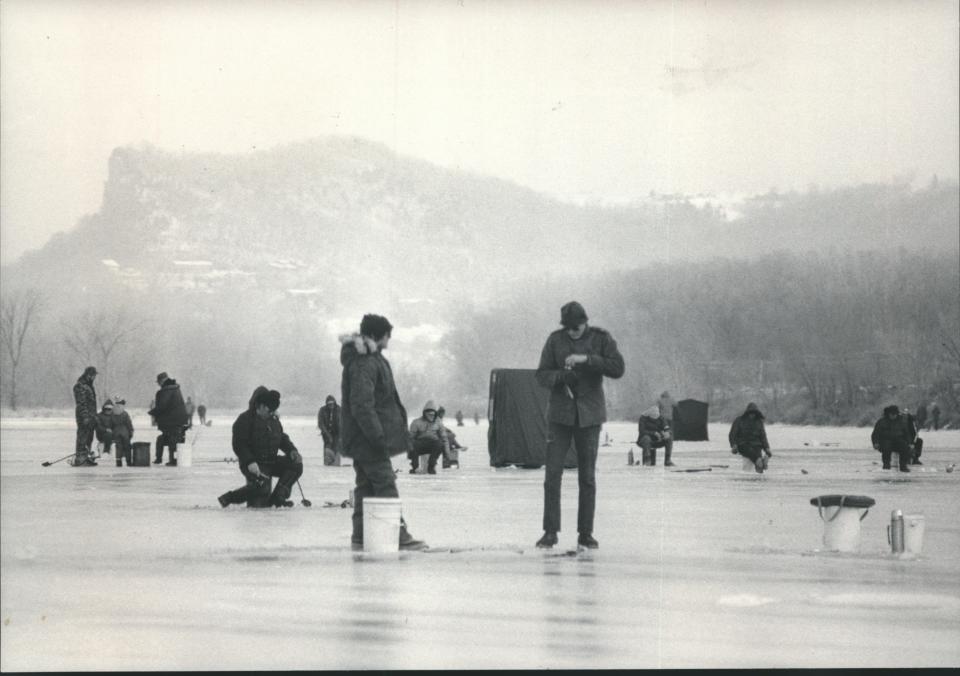In the winter, the Mississippi River is 'a magical place.' Here's how you can enjoy it.
When Kathi Jo Jankowski first went out to measure water quality on the upper Mississippi River in January 2017, the conditions she saw seemed otherworldly.
Jankowski, a research ecologist with the U.S. Geological Survey based in La Crosse, said being on the river felt like being in Antarctica, with snow, ice and whipping winds as far as the eye could see.
If you're making the journey across Wisconsin to see the Mississippi River, you might be predisposed to come at other times of year — to catch the impressive bird migration in spring or fall, perhaps, or during summer, to boat the river or drive down the Great River Road with the windows rolled down.
But in the winter, Jankowski said, the river is a magical place, one worth getting to know, even if you have to layer up.
Her advice: "Embrace winter, however you like to."
Here's what to know about the Mississippi River during the winter months.
Does the Mississippi River freeze in the winter?
In the north, yes. The offshoots of the river known as the backwaters freeze every year in Minnesota, Wisconsin and Iowa, Jankowski said.
Even the main channel, with its stronger current, can freeze over entirely in particularly cold years, Jankowski said. When that happens, it melts and refreezes throughout the winter depending on temperature and precipitation.
The backwaters are typically frozen by mid-December, and if the main channel is cold enough to freeze, that'll usually happen in early January, she said.
A freeze is less common as the river heads south, especially as the climate warms, but it wasn't unheard of throughout history. In St. Louis, for example, the river froze over at least 10 times between 1831 and 1938.
How cold is the Mississippi River in the winter?
If the river isn't frozen, its coldest point is probably just above freezing at 33 degrees Fahrenheit, Jankowski said.

Different parts of the river have different temperatures throughout the winter. The main channel is the coldest as cold water is constantly flowing from upstream, Jankowski said, while the shallower backwaters are generally warmer, making a comfortable wintertime resting spot for fish.
What winter wildlife can you see along the river?
Bald eagles are one of the biggest draws that pull people to the Mississippi in the wintertime, said Hallie Schulz, visitor services manager for the Upper Mississippi River National Wildlife and Fish Refuge.
Their migration peaks in February and early March, but already, many of them have congregated along the river, she said. If there's a spot that hasn't frozen over, they'll often sit along the edge of the ice, waiting to pluck out a fish. (La Crosse has an Eagle Watch wayside near the river where people can use viewing scopes to observe the birds.)

If the river freezes over, people may catch a glimpse of coyotes running across the ice, headed to destinations they haven't been able to get to all year, Schulz said.
And river otters will create "slides" down the snow into the water, she added, something people should look out for if they're out and about.
"It's like they have their own little sled," she said.
How is climate change affecting winter on the river?
Lake Pepin — the largest lake on the Mississippi River, which stretches roughly from Pepin to Bay City, Wisconsin — provides the longest record of ice cover on the river, starting in 1843, Jankowski said. Since then, the average date the ice melts in the springtime has shifted about two weeks sooner, she said, from mid-April to late March.
Between 2010 and 2020, an almost unprecedented amount of water flowed through the river, a result of increased precipitation and extreme flooding events that are expected to continue in the decades to come. In the wintertime, that blasted cold water into the backwaters, making those areas much less habitable for fish that prefer warmer, calmer spots.
That extra water also carries sediment from upstream, filling in the backwaters and making it harder for fish to breathe. Around the dams, the backwaters are losing half a centimeter to a centimeter of water per year, said Shawn Giblin, a water quality specialist for the Wisconsin Department of Natural Resources. As an ice fisher, he said he can personally point to dozens of areas where fish have simply left.
More: Climate change imperils the upper Mississippi River backwaters. Now nature needs human help.
That's one reason why he and a DNR co-author wrote in a 2020 report that "the backwaters of the Mississippi have suffered some of the most serious degradation as a result of changing climatic conditions."
Do the Wisconsin DNR and other agencies do research on the river during the winter?
Giblin and his team monitor those backwaters during the winter, measuring water temperature, velocity, depth and other metrics to study how the fish might be reacting. For some studies, they'll put sensors under the ice that take oxygen and temperature measurements every 15 minutes, he said — allowing them to understand what's happening even in the middle of the night.
The U.S. Geological Survey also monitors winter water quality on the upper Mississippi each year, Jankowski said, looking at water temperature, oxygen levels, nutrient pollution and algae formation. Researchers also measure ice and snow conditions.

Jankowski herself is working on a project to better map river ice cover using satellite data.
What's there to do during winter on the Mississippi River?
Ice fishing is — and has long been — hugely popular during winter on the upper Mississippi. In some areas, it's not uncommon to see a veritable community of ice shanties set up, Schulz said.

But if you forgot your pole, there's other things to do. Giblin said he enjoys cross-country skiing and ice skating on the backwaters in areas where he knows the ice is thick enough.
Watching for birds or simply looking for wildlife tracks across the ice can be fun activities, Jankowski said, especially if you're a budding photographer. And there's many a unique wintertime experience offered in towns along the river. Last year, for example, the Lake Pepin Legacy Alliance let people take a dip in the freezing lake and then sit in a wood-fired sauna as part of a fundraiser for the organization, which advocates for the health of the lake.
More: Three Wisconsin winter solstice hikes to celebrate the dark and the promise of sunlight to come
Above all, take a chance, bundle up and get out there.
"Too many people hibernate for the winter," Giblin said. "In Wisconsin, you're going to spend a third of your life waiting for conditions to improve."
What precautions should I take if I'm recreating?
If you're planning to venture out on the ice, it's best to use extreme caution, since the thickness of river ice can range widely. You can go from two feet of ice to two inches of ice really quickly, Giblin said.
People end up in the river every year, Schulz said. For those who aren't familiar with the area, she recommended sticking to shallow backwaters and carrying a large stick to test the ice ahead. (She also suggested exploring the Trempealeau National Wildlife Refuge, where people can get close to the river but don't have to get out on the ice.)
Warming conditions are making fluctuating ice cover more of a safety hazard, Jankowski said — and that could be especially true now, as Wisconsin's weather stays warmer-than-average through the new year.
Here's what the U.S. Army Corps of Engineers recommends for keeping yourself safe on the ice:
Never go out on the ice alone, and don't go out if there is any question of its safety
Avoid ice near open water
Talk to someone familiar with the area you are going to visit about ice conditions
Take a set of ice picks or nails to help you get back on the ice if you fall in
Let someone know where you are going and when you will be back
Remember that standing or parking in a group will require thicker ice
Remember that ice conditions can change from day to day
Have other questions about the Mississippi River? Email Madeline Heim at mheim@gannett.com. Heim is a Report for America corps reporter who writes about environmental issues in the Mississippi River watershed and across Wisconsin.
Please consider supporting journalism that informs our democracy with a tax-deductible gift to this reporting effort at jsonline.com/RFA or by check made out to The GroundTruth Project with subject line Report for America Milwaukee Journal Sentinel Campaign. Address: The GroundTruth Project, Lockbox Services, 9450 SW Gemini Dr, PMB 46837, Beaverton, Oregon 97008-7105.
This article originally appeared on Milwaukee Journal Sentinel: Things to do on the Mississippi River during winter

